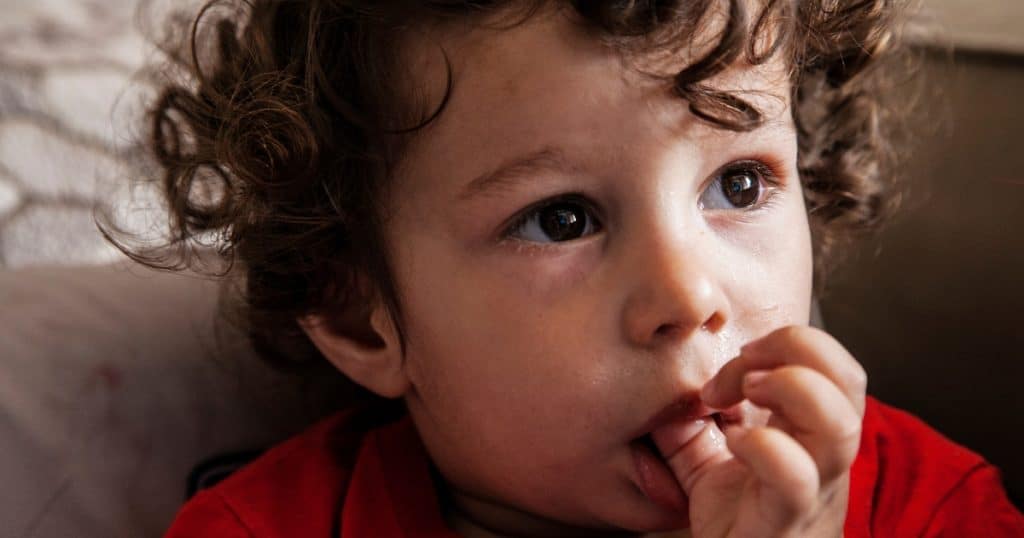We’ve all either heard of or seen babies and toddlers sucking their thumbs. It’s a common behavior as a child is growing up. However, thumb-sucking behavior isn’t limited to younger children. Many older children with autism spectrum disorder may suck their thumb as well.
This can be a common trait among autistic people. However, as parents, you may wonder what you can do to address thumb-sucking behavior as your child ages.
If you’d like to learn more about different behavior interventions, you can download your free guide here:
Download your FREE guide on
Autism Behavior Interventions
What causes thumb sucking in autism?
Similar to many other behaviors associated with autism spectrum disorder, the exact cause of thumb-sucking is unclear. However, various factors such as self-soothing, sensory stimulation, and anxiety have been suggested as possible contributors to this behavior.
Self-soothing behaviors
Children with autism often struggle with emotional regulation. Thumb sucking may provide them with a sense of security and comfort and help them self-soothe.
Sensory stimulation
It’s also not uncommon for children with autism to have sensory processing issues. They may need certain sensory input that thumb-sucking tends to address, allowing them to focus and remain calm.
Anxiety
Children with autism spectrum disorder also deal with high levels of anxiety or stress. Thumb sucking may be used as a coping mechanism to help them deal with anxious, stressful feelings.
Effects of thumb-sucking
While thumb-sucking behavior may provide a sense of calm for autistic people, it can negatively impact them as well. Thumb-sucking has been linked to dental problems, skin irritation, and infections. Dental problems are the most common issues that develop from thumb-sucking behavior.
The constant pressure from thumb-sucking can lead to tooth misalignment, affecting the person’s bite and how they chew. It can require braces, which can be a traumatic experience for some kids on the spectrum who may not understand what is happening during the procedure.

The misalignment can also lead to speech problems as the autistic child grows up.
Prolonged thumb sucking can also change the shape of the palate. This can lead to more serious health issues like breathing difficulties and sleep apnea.
How can parents manage thumb-sucking behavior?
While thumb-sucking can negatively impact your loved one’s health, there are methods parents and caregivers can use to help manage these behaviors.
Some of these methods include:
- Positive reinforcement – Parents can give their child a small reward for avoiding thumb-sucking behaviors. These rewards may motivate the child to stop this behavior all on their own.
- Distraction – Parents can try to keep the child’s mind off their thumbs by providing them with an alternative activity that keeps them occupied and redirects attention.
- Sensory stimulation – Parents can offer the child another item to pursue any oral stimulation they may need instead of their thumbs. My wife and I bought chewies for our son to help him with oral stimulation. While we were trying to move him away from a pacifier rather than thumb- or finger-sucking, the chewies can still work for all oral stimulation.
If these methods don’t work, it may be time to seek professional help.
Therapeutic approaches
Autistic people may need therapeutic remedies to help them stop engaging in thumb-sucking. Occupational and behavioral therapy proved to be effective approaches to manage this behavior.
Occupational therapy
An occupational therapist will focus on the child’s development, specifically regarding fine motor skills, and address sensory issues and how to regulate them. Being able to regulate the sensory system may help stop thumb-sucking behavior.

Behavioral therapy
A behavioral therapist can help parents and caregivers identify the triggers causing the thumb-sucking. The therapist and parents will develop strategies to replace the behavior with more appropriate coping mechanisms.
Alternatives to thumb sucking
While thumb-sucking may be hard to stop, it’s not impossible. Parents and caregivers can help provide alternative stimming behaviors to help their autistic children.
Some of these alternatives include:
- Providing a comfort object like a toy or special blanket that can help the child self-soothe but won’t damage their teeth.
- Playing games or with toys like silly putty, kinetic sand, or popping bubble wrap, which requires using hands.
- Using devices that are specifically designed to prevent thumb-sucking. This can be something as simple as a chewy or more complex device like a mouth guard.
Stay optimistic and persistent
While managing thumb-sucking can be tough, you have to stay persistent. Lapsing in persistence can lead to oral health problems down the road. These can include, but are not limited to, breathing problems, braces, and sleep apnea.
Still, it’s important to remain optimistic while encouraging your autistic children. Working with your children will help them recognize alternative self-stimulating behaviors, reduce stress, and remain calm. Working together, you and your child can address this behavior.
FAQs
Q: Is thumb-sucking a sign of autism?
A: Thumb-sucking is one of many repetitive behaviors that can be linked to autism. It is often used for emotional regulation and to help soothe the child. However, thumb-sucking behavior doesn’t automatically mean the child is on the spectrum.
Q: Is thumb-sucking more common in children with autism?
A: While thumb-sucking, in general, is not more common in children with autism, if the child is older and still engages in this behavior, then it is a more common habit in that demographic.
Q: At what age should I be concerned about my child’s thumb-sucking?
A: Most typically developing children stop thumb-sucking around age 4. If it continues into age 5, it may be of concern. It is after this age that the behavior can start affecting oral hygiene.
Resources
Al-Sehaibany FS. Occurrence of oral habits among preschool children with Autism Spectrum Disorder. Pak J Med Sci. 2017 Sep-Oct;33(5):1156-1160. doi: 10.12669/pjms.335.13554. PMID: 29142556; PMCID: PMC5673725.
Stricker, J. M., Miltenberger, R. G., Anderson, C. F., Tulloch, H. E., & Deaver, C. M. (2002). A Functional Analysis of Finger Sucking in Children. Behavior Modification, 26(3), 424-443. https://doi.org/10.1177/0145445502026003008
Weaver D, Philp AC, Hanson K. The Effects Of A Differential Reinforcement Of Other Behavior And A Faded Response Blocking Intervention On Decreasing Thumb Sucking Behavior In A Child With Autism Spectrum Disorder: A Case Study. J Med Case Rep Case Series https://acquaintpublications.com/article/the_effects_of_a_differential_reinforcement_of_other_behavior_and_a_faded_response_blocking_intervention_on_decreasing_thumb_sucking_behavior_in_a_child_with_autism_spectrum_disorder_a_case_study
Support Autism Parenting Magazine
We hope you enjoyed this article. In order to support us to create more helpful information like this, please consider purchasing a subscription to Autism Parenting Magazine.


